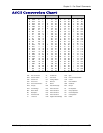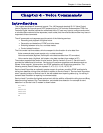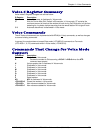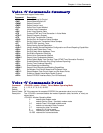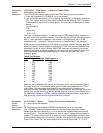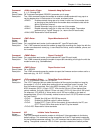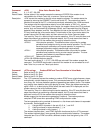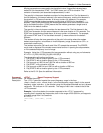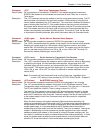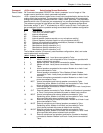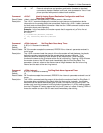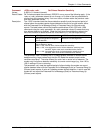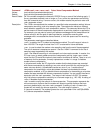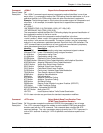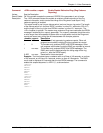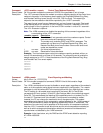
Chapter 4 – Voice Commands
Multi-Tech Systems, Inc. SocketModem MT5634SMIxx Reference Guide (S000263C) 110
Command: +VTX Start Voice Transmission Process
Result Codes: OK on completion of transmission; CONNECT if the modem accepts the command;
ERROR if the modem is not connected to at least one off-hook Telco line, or one non-
Telco device.
Description: The +VTX command causes the modem to start the voice transmission process. The PC
sends the data in the format of the previously entered +VSM command, using the flow
control method selected by the +FLO command. The voice data is buffered to withstand
gaps of missing data from the PC. If the modem does not have any current voice data,
the modem sends silence over to the analog destination until the PC provides more voice
data. The modem returns the OK result code and returns to Command mode after the
modem has completely transmitted its buffer contents. The Inactivity Timer can be used
to terminate the transmit data state, after which the modem returns to Command mode.
Command: +VGR=<gain> Set the Gain for Received Voice Samples
Values: 0–255
Result Codes: OK if the modem accepts the command; ERROR if the parameter is out of range.
Description: The +VGR= command causes the modem to set the gain for the received voice samples.
Receive gain values larger than 128 indicate a larger gain than nominal, and values
smaller than 128 indicate a gain smaller than nominal. The modem may limit the receive
gain to a narrower range, such as from 120 to 136, or from 120 to 128. The value 0 is
reserved for modem automatic gain control (AGC).
Command: +VGT=<level> Set the Volume for Transmitted Voice Samples
Result Codes: OK if the modem accepts the command; ERROR if the parameter is out of range.
Description: The +VGT= command causes the modem to set the volume control, either by attenuating
or amplifying the signal, for the transmitted voice samples. Values larger than 128
indicate a larger gain than nominal, and values smaller than 128 indicate a gain smaller
than nominal. The modem may limit the receive gain to a narrower range, such as from
120 to 136, or from 120 to 128. The value 0 is reserved for modem automatic volume
control (AVC).
Note: The modem will limit the transmit level over the Telco lines, regardless of the
current +VGT setting, to that permitted by CFR FCC Rules Part 68 – Subpart D.
Command: +VIT=<timer> Set DTE/DCE Inactivity Timer
Result Codes: OK if the modem accepts the command; ERROR if the parameter is out of range.
Description: The +VIT command sets the modem's initial value for the PC/Modem Inactivity Timer.
The permitted range is displayed by the +VIT=? command. The units are in 1.0 seconds.
The PC can disable the Inactivity Timer by using a value of 0 (+VIT=0).
The Inactivity Timer serves to ensure that the PC does not leave the modem in a state
where it is not accessible by voice-unaware software. The Inactivity Timer is activated
when the PC selects the voice fixed-rate. The timer expires if the flow of data from the PC
to the modem stops (in both Voice Command mode and Data mode) for a specified
amount of time.
When this timer expires, the modem switches to Data mode with autobauding. By
switching to autobauding (and Data mode), the PC is allowed voice-unaware software to
recover control of the modem in the event of catastrophic failure that does not result in a
modem power down. It is recommended that the PC software leave the modem in
autobauding (and Data mode), and use the Inactivity Timer only as needed. Leaving the
modem in autobauding is an extra measure to prevent confusion from voice-unaware
software accessing the modem in Voice mode at a fixed PC/modem interface rate. You
can use the H command to switch to autobauding and Data mode automatically. In Voice
mode, the modem does not allow the auto answer feature, since this feature does not
allow the PC to set the modem in Voice mode before answering the phone.



